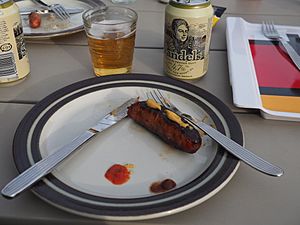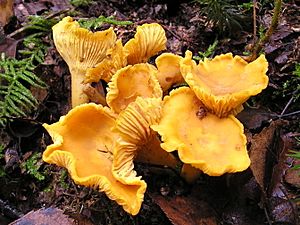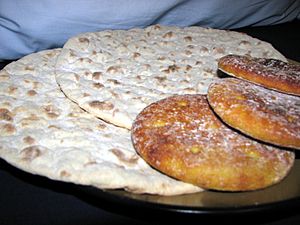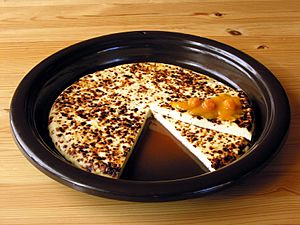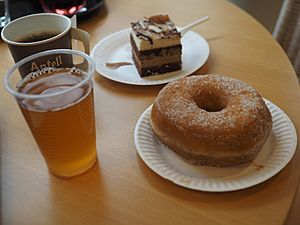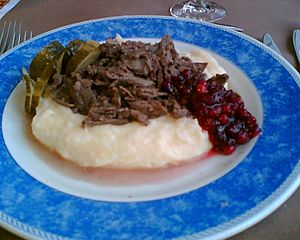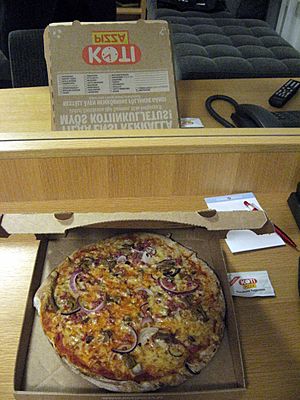Finnish cuisine facts for kids

Finnish cuisine is known for mixing traditional country food with modern cooking styles. In some parts of Finland, fish and meat (like pork, beef, or reindeer) are very important in traditional dishes. In other areas, people have traditionally eaten many different vegetables and mushrooms. After the Continuation War, people who moved from Karelia also brought their food traditions to other parts of Finland.
Finnish foods often use whole grain products such as rye, barley, and oats. They also use many berries like bilberries, lingonberries, cloudberries, and sea buckthorn. Milk and products made from milk, like buttermilk, are commonly used in food, as drinks, or in recipes. In the past, different kinds of turnips were common in cooking. However, the potato became popular in the 18th century and replaced turnips.
Contents
What Makes Finnish Food Special?
For a long time, the way of life in Finland was mostly based on farming. But because the weather was often harsh and cold, farming wasn't always easy or safe. So, finding food from nature was often a very important way to survive, especially when crops failed. Farms mostly grew plants like grains or turnips. Families often had only a few farm animals for milk and meat. Because of this, hunting and especially fishing were important ways to get more protein. Eating meat every day only became common in the early 1900s. Before that, in the 1800s, there were times when people didn't have enough food because crops failed.
In the past, Finland's cold climate meant that fresh fruits and vegetables were hard to find for about nine months of the year. This made people rely a lot on root vegetables (first turnips, then potatoes), dark rye bread, and fermented milk products. Sometimes, they added preserved fish and meat. Traditionally, people used very few spices other than salt. Fresh herbs like dill and chives were only available in summer. Many traditional Finnish dishes are cooked slowly in an oven. This makes them hearty and filling.
Forests and lakes have always been a major source of food in Finland. Today, foods from the forests still give Finnish cuisine its special taste. Modern Finnish chefs now use fresh, high-quality Finnish products with cooking methods from other countries. This helped a restaurant in Helsinki called Chez Dominique get two Michelin stars in 2003. The restaurant closed in 2013.
As Finland became more connected to the world, new foods arrived. Pasta, pizza, kebab, and hamburgers became popular. They took the place of some traditional everyday dishes like kaalilaatikko (cabbage casserole) or herring fillets. Today, many Finnish women work outside the home. Because of this, many traditional dishes that take a long time to prepare are now saved for holidays.
Even with modern farming and transport, food is still expensive in Finland compared to other European countries. When Finland joined the European Union in 1995, trade barriers were removed. This caused prices for things like grains, meat, and milk to drop by as much as 50%. Before that, high taxes and bans on imported foods made it hard to find foreign or out-of-season food. Now, Finnish supermarkets and restaurants offer many different foods from all over the world.
Finnish food is very similar to Swedish cuisine. In fact, Swedish dishes like Janssons frestelse (janssoninkiusaus), pyttipannu, and gravlax are common in Finland. The main difference is that Finns prefer foods that are not sweet. For example, traditional Swedish rye bread has a lot of syrup and spices, but Finnish rye bread is unsweetened, even a bit bitter. Finnish food also has some similarities to German cuisine and Russian cuisine. Sausages and buttered bread (like Butterbrot), and kiisseli (kissel) and {{lang|fi|lihapiirakka]] (like pirozhki) are similar to their German and Russian versions. However, Finnish recipes often use fresh ingredients instead of canned or pickled foods. This is because fresh vegetables, fish, and meat are available all year round.
Delicious Finnish Food
Meats in Finland
The most popular meats in Finland are pork (people ate about 33.5 kg per person in 2005), beef (18.6 kg), and chicken (13.3 kg). About one-third of this meat is eaten as sausage (makkara). Sausages are mostly made from pork but often include other meats too. Horse meat, lamb, and reindeer are eaten less often, but they are easy to find.
Besides farm animals, hunting and fishing have long traditions in Finland. Hunters mostly look for deer, moose, and bear. Smaller animals like hare, duck, and grouse are also popular. About 70,000–80,000 moose are hunted each year, providing a lot of meat. Because of very strict food rules, moose meat is mostly eaten by families and is rarely found in restaurants.
Berries
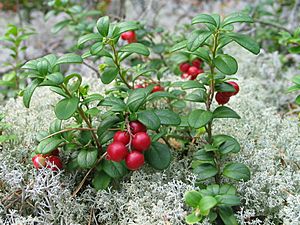
Wild berries from the Arctic are a special part of Finnish food. They have a strong flavor and lots of nutrients. In the past, people ate them fresh in summer and dried them for other times of the year. It's still very common to go pick berries directly from the forests. Wild berries are free to pick in any forest, whether it's state-owned or private, as long as it's not too close to homes (this is part of the Freedom to roam rule).
Wild raspberries, bilberries, and lingonberries (also called cowberries) can be found almost everywhere in Finland. However, cloudberries, cranberries, arctic brambles, and sea buckthorns grow in smaller areas. The very flavorful wild strawberry (metsämansikka) is a special treat in season. It's used to decorate cakes, or served alone with cream or ice cream. Farmed strawberries are also very common.
Today, berries are usually frozen for winter, not dried. They can be used in recipes or eaten on their own, for example, with porridge and sugar. Kissel (a sweet soup made from berry juice and berries, thickened with potato starch) is a common dessert. Homemade berry juices and jams are popular, especially among older people. While berries are most often used for desserts, they are also served with meat, especially sour lingonberry relish.
Bilberry kiisseli and pie, made from wild bilberries (Vaccinium myrtillus), are traditional Finnish desserts. Bilberries are often used in Finnish cooking, both as an ingredient in things like bilberry pie, and also served with cream or ice cream. They are often put on top of viili and other yogurt-like dishes.
Fish
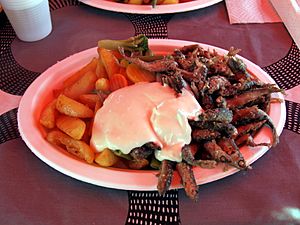

Lakes and rivers in Finland, along with the Baltic Sea, offer many chances for fishing. Fish has always been an important source of protein. Many ways of preparing fish are used, including frying, boiling, drying, salting, fermenting, cold smoking, or simply slicing sea fish and eating it raw. Salmon is a popular choice, either as kylmäsavustettu lohi (cold smoked salmon, like Lox), or served raw with lemon juice as graavilohi (called gravlax in Swedish). The soup called lohikeitto is also one of the most popular salmon dishes in Finland. It is common to smoke all types of fish, such as salmon, zander, pike, perch, and Baltic herring. A popular dish among the Swedish-speaking people is smoked herring (Finnish: savusilakka, Swedish: böckling).
There are many kinds of pickled herring, which is a common appetizer. It's also served around Midsummer with small potatoes called uusiperuna (nypotatis in Swedish), which means 'new potato'. These are usually the first potatoes harvested. Whitefish and vendace roe (fish eggs) are Finnish treats served on toast or with blinis. Crayfish can be found in many lakes and streams in Finland. Especially in August, the Swedish-speaking population often has parties focused on eating crayfish.
Mushrooms
Many kinds of mushrooms grow in Finnish forests. False morels start the season in spring and are used in creamy dishes. Chanterelles and ceps appear after Midsummer and are popular everywhere. In eastern Finland, almost all edible mushrooms are eaten, including milkcaps and russulas. Most mushroom recipes come from Russia, as Finns used mushrooms for dyeing fabrics more than for food in the past. Mushrooms are used in soups, sauces, stews, pie fillings, or simply fried in a pan with onions as a side dish. They are kept for winter by pickling or drying. Chanterelles are often used in fancy Finnish cooking, along with their relatives, winter chanterelles, which often end the season. Just like picking berries, mushroom hunting is also a popular outdoor activity for Finns.
Bread
Dark and fiber-rich ruisleipä, or rye bread, is a very important part of the Finnish diet. Breads are made from grains like barley, oat, rye, and wheat. Sometimes, different grains and flours are mixed. For example, sihtileipä is made from a mix of rye and wheat. There are also different kinds of flatbreads called rieska. These include maitorieska (milk flatbread), ryynirieska with barley grits from Savonia, and läskirieska (lard flatbread), which is a flat barley bread with pieces of lard from the Western coast. There is also perunarieska (potato flatbread). In Kainuu, North Finland, the flatbreads are very thin and baked over an open flame. Näkkileipä, which is crisp rye bread, is also common.
In the 1800s, when crops failed and people faced hunger, Finns had to make pettuleipä or bark bread. This bread was made from rye flour and the soft inner layer of pine bark. It was nutritious but very hard and not tasty at all. It was also eaten during the Second World War. Today, some people have started making this bread again, saying it has health benefits.
Porridges
Finnish breakfast usually includes a good amount of porridge. Porridge made from rolled oats, rye, or mixed grains is most common. But there are other choices, like the milk-based mannapuuro (semolina-milk porridge) and helmipuuro (starch grain-milk porridge). Porridges are often eaten with milk, sugar, butter, or berry kiisseli. During Christmas, people eat milk-based rice porridge (riisipuuro). It's sprinkled with cinnamon and sugar and often topped with prune kiisseli (luumukiisseli). There's also a semolina-based porridge flavored with fresh or frozen lingonberries called vispipuuro ("beaten porridge").
Drinks
Water and coffee are the most common drinks in Finland. During meals, milk and sour milk (piimä, a fermented milk) are also popular, even for adults. Coffee is often drunk many times a day and is served everywhere. In fact, Finland has the highest coffee consumption per person in the world. Tea is also available in most homes.
Desserts
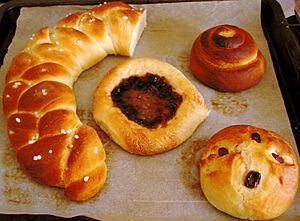
- Pulla – a sweet bread flavored with cardamom, eaten with coffee or as a dessert.
- Cinnamon rolls (korvapuustit) – pulla shaped into a roll with cinnamon and sugar.
- Golden cloudberry dessert.
- Kiisseli – made from water, sugar, berry juice, and berries (often canned or frozen today). It's thickened with potato starch flour and served with milk or cream and sugar. These can be less runny than a drink-like mustikkakeitto (Swedish: blåbärssoppa), depending on how they are made, but they are not like jelly.
- Runeberg torte – named after the national poet Johan Ludvig Runeberg. It's served on his memorial day, February 5.
- Rönttönen – a pastry with a lingonberry filling.
- Uunijuusto – a baked milk dish eaten with berries.
- Vispipuuro (whipped porridge) – a sweet pink dessert porridge with lingonberries or other berries, served with milk and sugar.
Sweets
- Salmiakki – a salty black liquorice candy.
- Fazer Blue – a popular milk chocolate.
- Wood tar (terva) flavored candy, like Terva Leijona.
Examples of Finnish Dishes
The term perinneruoka ("traditional dish") often refers to special foods that are not eaten every day. These foods are often linked to certain regions, older generations, or specific holidays. For example, mämmi is eaten on Easter. Most people eat these dishes rarely or not at all. To compare, the term kotiruoka ("home-made food") refers to everyday staple dishes. Meatballs, pea soup, and rye bread are examples of such daily foods.
Here is a list of typical dishes traditionally eaten in Finland.
Common Finnish Dishes
- Kaalikääryleet – cabbage rolls.
- Game food – dishes made from moose, deer, grouse, duck, hare, and more. These are rarely found in restaurants, except the very best ones. They are common among people who enjoy hunting.
- Hernekeitto – pea soup, usually served on Thursdays, often with pancakes for dessert.
- Leipäjuusto (also called hiilikko and juustoleipä) – a soft cheese similar to halloumi.
- Viili – a yogurt-like fermented milk product.
- Perunamuusi – mashed potato, a common side dish.
- Lihapullat – Finnish meatballs, often in gravy and with lingonberry sauce on the side.
- Palvikinkku and palviliha – smoked ham or beef.
Holiday Foods
Shrove Tuesday
- Hernekeitto – pea soup made with ham.
- Laskiaispulla – ('Shrovetide pulla') filled with whipped cream and almond paste or jam.
Easter
- Mämmi – an Easter dessert pudding. It's a sweetened, oven-baked rye malt porridge, served with sugar and milk or cream. It can be found frozen all year. In the past, during Catholic times, it was a food for Lent and also served on Good Friday.
- Pasha – a dessert made of quark, butter, eggs, and spices. It comes from Russia.
Vappu (May Day)
- Sima – a type of mead, which can be homemade or bought.
- Munkki – a deep-fried pulla covered in sugar, similar to doughnuts.
- Tippaleipä ('May Day fritters') – a type of funnel cake.
Christmas
- Joulupöytä ('Christmas table') – includes many dishes, some of which are almost only eaten at Christmas, like lipeäkala.
- Glögi – mulled wine, served during the holiday season.
Food from Different Regions
Lapland
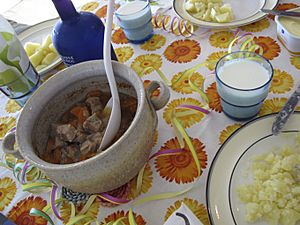
- Sautéed reindeer (poronkäristys).
- Lohikeitto – salmon soup with cream.
Kainuu
- Rönttönen – a pastry with lingonberry filling (it has special PGI protection under EU law).
- Smoked meat soup.
- Kainuun Juustoleipä – a type of Bread Cheese.
- Vendace fish soup.
- Pettuleipä ('Pettu-bread') – a bark bread made from rye flour and pine phloem during times of hunger.
Karelia
- Karelian pasties – popular throughout all of Finland.
- Karelian stew – often eaten on Finland's Independence Day and at Christmas.
- Sultsina – sold at the market square in Joensuu and other places in the area.
Ostrobothnia and Åland
Because these areas are on the West coast, their food has some special local dishes.
- Klimpsoppa – flour dumpling soup.
- Åland's pancake – usually made from leftover porridge and served with plum jam.
- Swedish svartbröd ('black bread') – eaten in Swedish-speaking Åland. A similar dark bread, known as skärgårdslimpa ('islander's bread', referring to Åland), is made on the southern coast and in Malax on the Ostrobothnian coast (malaxlimpa). This dark brown bread is made from rye and has a lot of dark syrup.
Other Special Dishes
- Kesäkeitto – a traditional vegetable soup with butter and milk.
- Mustamakkara – blood sausage from Tampere.
- Rössypottu from Oulu – a mix of blood pudding and pork stew.
- Hapanvelli – a rye and pea porridge from Virolahti.
- Kakko – a type of white bread baked mostly in the Satakunta region.
Meals in Finland
Finns usually eat three meals a day: breakfast, lunch, and dinner. In all primary and secondary schools, including high school, a hot free lunch is served. This is part of Finland's welfare state system. Lunch is eaten around noon and is usually a warm meal. Some people might choose a lighter meal like a sandwich or a salad. Bringing a lunchbox from home is not as common as in other parts of Europe. Universities also provide lunch for students, but it's not free; students pay a reduced price.
Lunch usually has one main course with an optional side salad, bread, and dessert. Many workplaces have a lunch restaurant. If not, employers often give lunch vouchers. Restaurants often have a special lunch menu for this purpose. In the evening, dinner is usually a hot meal, also with side dishes. Meals are usually single-course. They commonly include some kind of meat (pork, lamb, chicken, beef) and potatoes, rice, or pasta. Soups, like pea soup or fish soup, are not just appetizers. They can be served as lunch or dinner and are therefore heavier and come in larger portions.
Breakfast
Breakfast is seen as an important meal and usually includes open sandwiches. The sandwich often has butter and savory toppings like hard cheese or cold cuts. Sour milk products like yogurt or viili are also common breakfast foods. These are usually served in a bowl with cereals like corn flakes and muesli, sometimes with sugar, fruit, or jam. A third common breakfast food is porridge (puuro). It's often made from rolled oats and eaten with a pat of butter (voisilmä, meaning 'butter eye') or with milk, fruit, or jam, especially raspberry or strawberry jam (sometimes lingonberries). Drinks include milk, juice, tea, or coffee.
Coffee Breaks
Finland has the highest coffee consumption per person in the world. On average, Finns drink about 12 kilograms of coffee per person each year. It's common for a Finn to drink coffee throughout the day, often with a sweet bun or a sandwich. Most workplaces set aside time for coffee breaks. Serving coffee is also a common courtesy when visiting a private home.
What People Say About Finnish Food
In 2005, Finnish food was criticized by two leaders from countries famous for their cuisine. The Italian prime minister Silvio Berlusconi said, "I've been to Finland and I had to endure the Finnish diet so I am in a position to make a comparison." Berlusconi started criticizing Finnish food in 2001. He also said, "The Finns don't even know what prosciutto is." This happened after the European Commission decided to put the European Food Safety Authority in Helsinki. On July 4, 2005, French President Jacques Chirac said that "After Finland, [Britain is] the country with the worst food."
After Jacques Chirac's and Silvio Berlusconi's comments, some international food reporters responded: "Chirac and Berlusconi are wrong! Finnish cuisine is much more international than I expected. I have eaten very good food in wonderful restaurants, visited market places and enjoyed good cafeterias. Cheese is very good in Finland. I also love Finnish cloudberry and smoked fish." (Ute Junker, Australian Financial Review Magazine, Sydney, Australia)
"Food in Finnish restaurants is extremely good. Especially I love Finnish salmon, mushroom soup and desserts. I have also got very good Finnish wines. The worldwide reputation of Finnish cuisine isn't very good – but it should be!" (Liliane Delwasse, Le Figaro, Paris, France)
"I have eaten only good food in Finland. Food in Finland is very fresh. Bread, berries, mushrooms and desserts are very delicious. Finnish berries (especially cloudberry), salmon, cheeses and reindeer should be available in London, too." (April Hutchinson, Abta Magazine, London, England).
The Finnish pizza chain Kotipizza won the 2008 America's Plate International pizza contest in New York. Italian-American pizza came in second. Kotipizza named their winning smoked reindeer pizza Berlusconi. This was a symbolic way to get back at the Italian prime minister for his earlier criticism of Finnish food.
See also
 In Spanish: Gastronomía de Finlandia para niños
In Spanish: Gastronomía de Finlandia para niños


